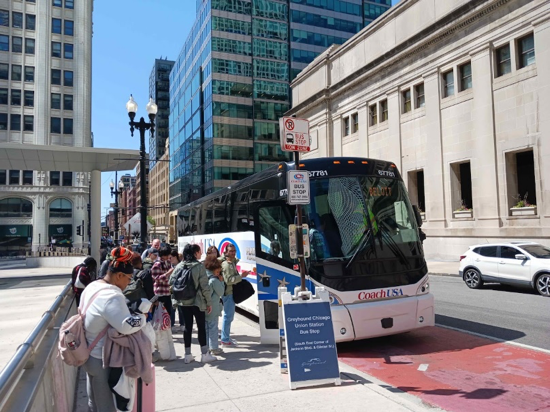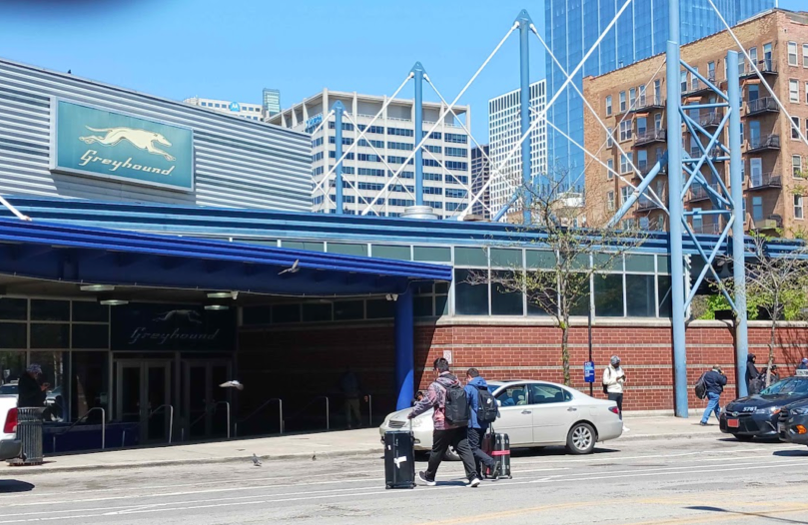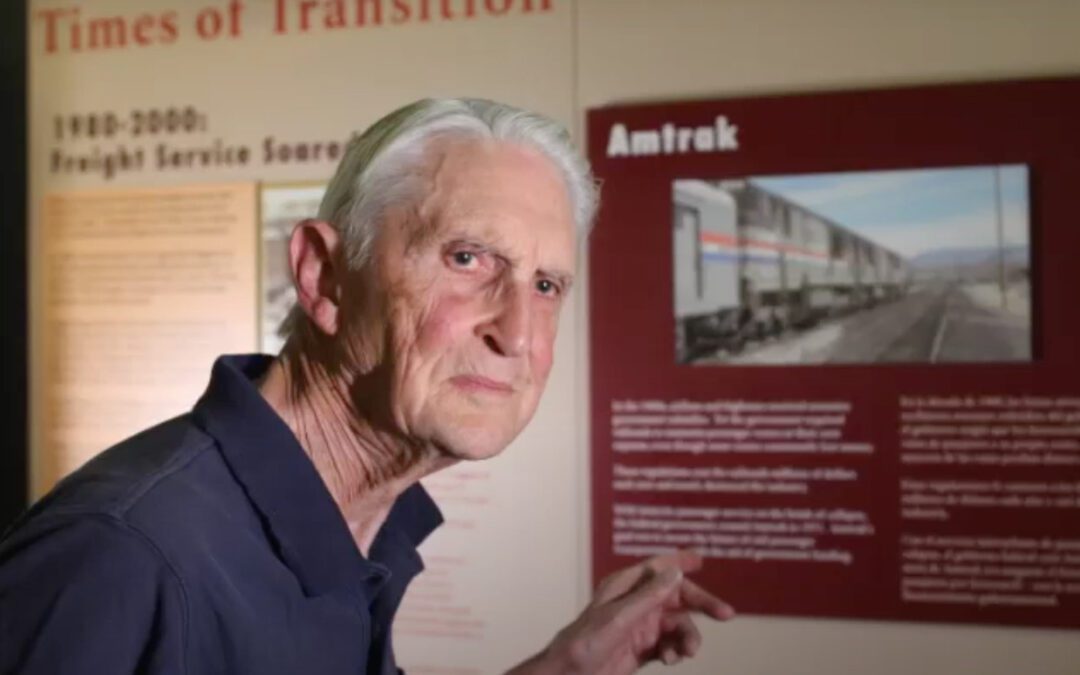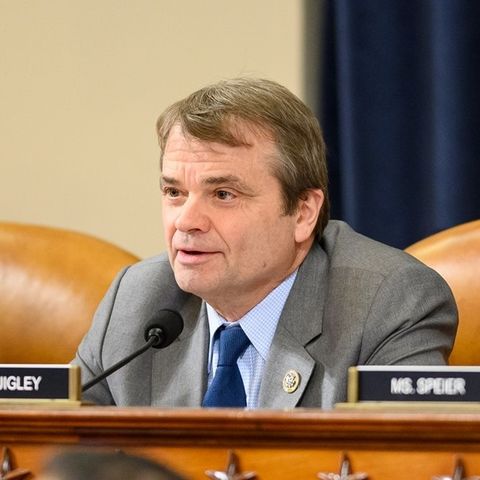Post by: Rick Harnish, Executive Director Transportation Secretary Pete Buttigieg was interviewed by former Secretary Ray LaHood in front of a standing-room-only crowd at the US High Speed Rail Conference this week. I left the event motivated by knowing that Sec....
The push to make Chicago a more attractive and comprehensive intercity ground travel hub will suffer a severe setback if bus lines are evicted from Chicago Greyhound Terminal. Greyhound’s lease ends in October, and the City of Chicago has not taken action to prevent it from being sold for residential development.
The site, just three blocks from Chicago Union Station (CUS) at 630 W. Harrison, could be acquired by the City, or another a public agency, for around $30 million. That is a fraction of what it would cost to build an inferior replacement.
This cost is a manageable sum and a wise investment for a region as large as metropolitan Chicago, we argue in our new Intercity Bus Blues brief. However, time is of the essence, as the owner is likely growing impatient with the city’s inaction. Several months will be required to allow a smooth transition to another location if one can be found. In mid-2023, discussions between the City of Chicago staff, bus lines, elected officials, and the owner, Twenty Lakes Holding, provided hope that these parties were working towards a resolution. Twenty Lakes (which has no connection to the bus industry) appears willing to negotiate in good faith. Yet, the City has opted to do nothing.

Intercity buses that connect with Amtrak stop on the street outside Union Station, a less ideal solution.
Could the apparently underutilized CTA transit center next to CUS handle some (or all) of the Greyhound station’s operations? What about the southernmost lane on Jackson Boulevard used by Amtrak Thruway bus services, including Van Galder runs to Madison, Wis., and Greyhound trips to Indianapolis and Milwaukee? We don’t know the answer to either question because the City has yet to present any analysis.
What is clear is that a do-nothing strategy is untenable. An estimated half-million passengers, many of whom are making bus-to-bus transfers, use the Terminal annually. The facility is served by four bus lines and has a spacious seating area, a cafeteria, and other amenities. An efficient downtown bus facility is needed to improve the synergy between buses and trains, which could benefit both modes of travel.
Other states are investing heavily in expanding bus/train synergy. For example:
- California’s extensive Amtrak Thruway bus scheduled to encourage transfers with trains. The state also sells many intrastate bus services on amtrak.com and even allows reservations for bus-only trips on the platform, putting most scheduled ground options in one place.
- Oregon supplements its four daily Portland–Eugene trains with two bus trips, resulting in relatively even departure spacing throughout the day.
- Vermont staggers bus and train services on the Albany, NY–Burlington, VT route, with buses serving many locations missed by trains.
- Washington State supplements its twice-daily Seattle–Vancouver, BC train service with two bus trips and is evaluating the possibility of expanding bus connections as part of its range corridor expansion plan.
These strategies make amtrak.com a much more powerful booking site.
Midwestern states are also getting in on the act. Michigan has prioritized creating multimodal stations serving intercity buses, public transit, and train services. The state will also help build a new consolidated bus and train station in Detroit near the nearly reimagined Michigan Central Station. Wisconsin has helped develop well-timed transfers between trains and buses in Milwaukee to allow for fast Chicago–Green Bay, WI trips, with some connections less than 15 minutes.
Where is Illinois in this movement? Regrettably, it is mostly absent. No bus service to Downstate is scheduled primarily to foster efficient bus/rail connections, and there are prominent gaps in the network.
- Despite three trains in each direction on the Chicago–Champaign–Carbondale route, there are no departures on amtrak.com southbound from the Windy City between 8:15 a.m. and 4:05 p.m. or after 8:05 p.m.
- Five trains run in each direction between Bloomington-Normal and Chicago. However, the earliest arrival in Chicago is at 9:25 a.m., which is too late for those attending full-day events, particularly when accounting for delays. The last southbound train, departing at 7:10 p.m., is too early for those working late or attending evening events. Large gaps emerge when the Texas Eagle or other trains sell out, which is expected due to strong demand and Amtrak equipment shortages. Yet, all direct downtown Chicago – Bloomington-Normal bus service has been dropped.
- Decatur, Freeport, and Galena have no intercity schedule ground transportation of any kind.
Additional bus services would connect traffic generators that are a considerable distance from Amtrak, such as the campuses of Eastern Illinois University in Charleston, Southern Illinois Edwardsville, and Olivet Nazarene University in Bourbonnais, to the network. Similarly, existing Chicago–Quad Cities bus service could be added to the Amtrak Thruway network to fill a void in the Amtrak system until train service becomes available.
Pursuing such opportunities will become far more difficult if the Chicago Greyhound Station is lost and an adequate replacement near CUS cannot be found. Advocates of intercity ground transportation must work together to prevent that from happening. We will continue to push the City of Chicago, the Illinois Department of Transportation, and other governmental units to take action to avoid a crisis.
Joseph Schwieterman is a professor of Public Service and director of the Chaddick Institute for Metropolitan Development at DePaul University. Click here to access his new study or email [email protected] to sign up for the semi-monthly monthly Intercity Bus E-News.
Get more background and learn why saving the Greyhound station is important to high-speed rail.
The Latest from HSRA
Our Latest Blog Posts
Check out the latest news, updates, and high speed rail insights from our blog!





